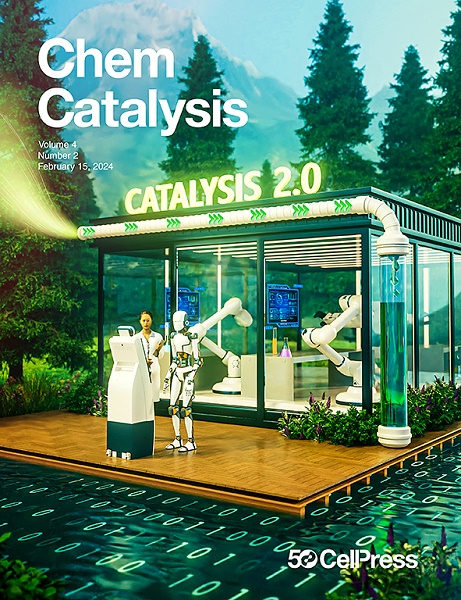可调层间距的二维mxene负载钌催化剂上的塑料废物氢解
IF 11.6
Q1 CHEMISTRY, PHYSICAL
引用次数: 0
摘要
塑料的氢解受到活性位不可达性和大块聚合物链质量传递效率低的限制。为了克服这些挑战,本工作开发了二维mxene负载的Ru (Ru@MXene)催化剂。对含有分散的MXene薄片和Ru前体的溶液进行冻干,可以将Ru物质限制在MXene中间层内,作为扩大中间层间距的支柱。在此基础上,具有更大层间距的二氧化硅柱mxene负载Ru (Ru@P-MXene)的反应速率为914.9 gC5-C35 gRu−1 h−1,用于将低密度聚乙烯(LDPE)氢解成有价值的液体化学品(例如C5-C35)。Ru@P-MXene和Ru@MXene之间的产物产率的比较表明,被限制在MXene支架内的拉长的Ru颗粒暴露了它们的侧面以进行反应。这项工作展示了MXene在热化学催化中的新应用,为化学塑料升级回收中活性位点可及性、质量传输和反应限制的挑战提供了解决方案。本文章由计算机程序翻译,如有差异,请以英文原文为准。

Plastic-waste hydrogenolysis over two-dimensional MXene-supported ruthenium catalysts with tunable interlayer spacing
The hydrogenolysis of plastics is limited by active-site inaccessibility and inefficient mass transport of bulky polymer chains. To overcome these challenges, this work developed two-dimensional MXene-supported Ru (Ru@MXene) catalysts. Lyophilization of a solution containing dispersed MXene sheets and Ru precursors enabled the confinement of Ru species within the MXene interlayers, which act as pillars to expand the interlayer spacing. Building on this, a silica-pillared MXene-supported Ru (Ru@P-MXene) with even larger interlayer spacing exhibited a reaction rate of 914.9 gC5–C35 gRu−1 h−1 for the hydrogenolysis of low-density polyethylene (LDPE) into valuable liquid chemicals (e.g., C5–C35). A comparison of product yields between Ru@P-MXene and Ru@MXene suggests that elongated Ru particles confined within the MXene support expose their side facets for the reaction. This work demonstrates a new application of MXene in thermochemical catalysis, offering a solution to the challenges of active-site accessibility, mass transport, and reaction confinement in chemical plastic upcycling.
求助全文
通过发布文献求助,成功后即可免费获取论文全文。
去求助
来源期刊
CiteScore
10.50
自引率
6.40%
发文量
0
期刊介绍:
Chem Catalysis is a monthly journal that publishes innovative research on fundamental and applied catalysis, providing a platform for researchers across chemistry, chemical engineering, and related fields. It serves as a premier resource for scientists and engineers in academia and industry, covering heterogeneous, homogeneous, and biocatalysis. Emphasizing transformative methods and technologies, the journal aims to advance understanding, introduce novel catalysts, and connect fundamental insights to real-world applications for societal benefit.

 求助内容:
求助内容: 应助结果提醒方式:
应助结果提醒方式:


